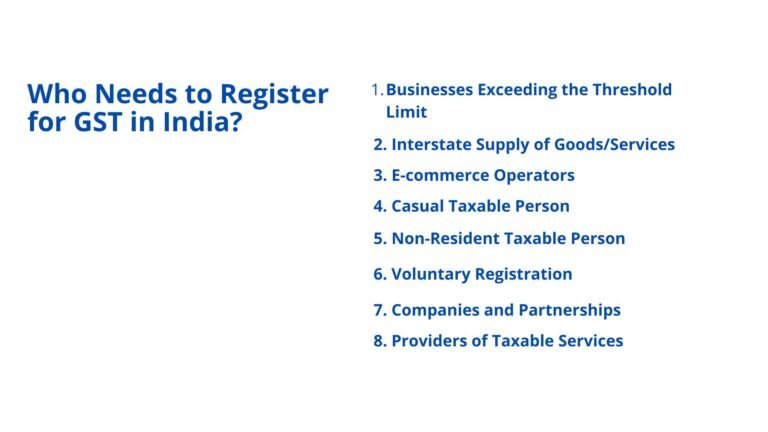INDEX
What is GST ?
Who needs to Register for GST in India
Who Doesn’t needs to Register for GST in India
How to register for GST in india
Post Registration Requirements
GST Registration in India:
Who Needs to Register & How to Do It ?
1. What is GST?
The Goods and Services Tax (GST) is India’s comprehensive indirect tax on the supply of goods and services. It replaced multiple state and central taxes to create one unified system across the country.
If you’re running a business that crosses a certain turnover limit — or involved in specific kinds of supply — GST registration becomes mandatory. Let’s break down who needs to register and how to go about it.

2. Who Needs to Register for GST in India?
GST registration applies to several categories of individuals and entities. Here’s a clear rundown:
a. Businesses Exceeding the Threshold Limit
For Goods:
If your total yearly turnover crosses ₹40 lakhs (₹20 lakhs for Special Category States such as Jammu & Kashmir, Himachal Pradesh, Uttarakhand, etc.), registration is mandatory.
For Services:
If your service turnover exceeds ₹20 lakhs (₹10 lakhs for Special Category States), you must register.
Note: Aggregate turnover includes taxable and non-taxable supplies across all your business activities during the financial year.
b. Interstate Supply of Goods or Services
If you supply goods or services from one state to another — even once — GST registration becomes compulsory, no matter your turnover.
c. E-Commerce Operators
Selling through platforms like Amazon or Flipkart? You’ll need to register for GST, even if your turnover is below the threshold.
d. Casual Taxable Person
If you occasionally carry out business in another state — say, at an exhibition or trade fair — you’re considered a casual taxable person and need to register, regardless of turnover.
e. Non-Resident Taxable Person
Foreign businesses or individuals supplying goods or services in India must obtain GST registration before starting operations here.
f. Voluntary Registration
Even if your turnover is below the limit, you can register voluntarily. It’s not mandatory, but it allows you to claim input tax credit and gives your business more credibility.
g. Companies and Partnerships
If you’re a company or partnership firm that meets the turnover threshold or trades across states, GST registration is required.
h. Providers of Taxable Services
Professionals like doctors, chartered accountants, and lawyers offering taxable services must register once their turnover crosses the applicable limit.
3. Who Doesn’t Need to Register for GST?
Not everyone needs to get a GST number. The following categories are generally exempt:
Small Businesses: Those with turnover below ₹40 lakhs (for goods) or ₹20 lakhs (for services).
Agriculturists: Farmers engaged only in the supply of agricultural produce.
Government & Local Bodies: Departments, local authorities, and certain non-profit organizations — unless they’re offering taxable services.
4. How to Register for GST in India
GST registration is entirely online and can be completed through the official GST portal. Here’s how to get it done step-by-step:
Step 1: Head Over to the GST Portal
Go to www.gst.gov.in.
Step 2: Select “Services”
Click Services → Registration → New Registration to start the process.
Step 3: Fill Out Part A of the GST Form
You’ll need to enter:
Legal name of the business (as per PAN)
PAN number (mandatory)
Email ID and mobile number (for OTP verification)
State and district of business location
Once you verify with OTPs sent to your email and phone, you’ll receive a Temporary Reference Number (TRN).
Step 4: Complete Part B
Log in with your TRN and continue filling out the remaining details:
Type of business (proprietorship, partnership, company, etc.)
Nature of business (trading, manufacturing, services, etc.)
Bank account details (account number, IFSC, etc.)
Proof of business address (rent agreement, electricity bill, etc.)
Step 5: Upload Required Documents
Keep these handy:
PAN Card
Proof of business address
Bank statement or passbook copy
Aadhaar card of the authorized signatory
Passport-size photo of the owner/signatory
Step 6: Submit the Application
After verifying everything, submit your application. You’ll get an Application Reference Number (ARN) to track its status online.
Step 7: Receive Your GST Registration Certificate
Once the authorities verify your details, you’ll receive your GST Registration Certificate within 3–7 working days — provided all documents are in order.
5. Post-Registration Requirements
After registration, you’ll receive your GSTIN (GST Identification Number) — a unique 15-digit code that must appear on every invoice, return, and tax document.
Here’s what follows:
1. Filing GST Returns
Once registered, you must file monthly or quarterly GST returns and pay taxes on time. Common returns include GSTR-1, GSTR-3B, and others.
(For a more detailed breakdown, check out our article on GST Return Filing.)
2. Maintaining Compliance
Keep your business GST-compliant by:
Issuing proper invoices
Collecting and remitting GST correctly
Filing returns within due dates
Staying compliant avoids penalties and keeps your business running smoothly.

Conclusion
GST registration is a crucial step for any business operating in India. It’s not just a legal formality — it also adds legitimacy and allows input tax credit benefits.
The entire process is online, straightforward, and once done, your business becomes part of India’s unified tax system.
If you’re unsure whether you need to register, or you’d like help navigating the process, it’s wise to consult a qualified tax professional or GST expert.